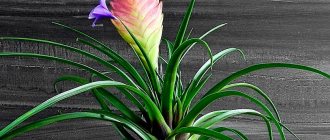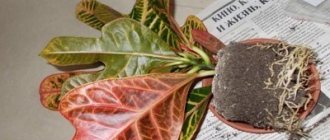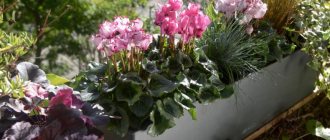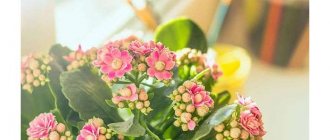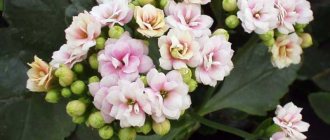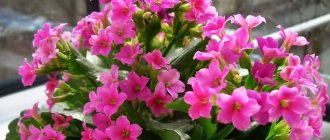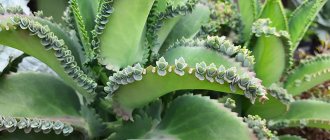What to look for when buying Kalanchoe
If you are going to immediately use the plant for medicinal purposes, you need to take it from friends or your grandmother at the nearest market, and not in a store. There, Kalanchoe is definitely stuffed with fertilizers or stimulants, which will not bring anything good to a person.
When purchasing decorative species, you need to pay attention to the following:
- The leaves should not have spots, spots, rot, or any other damage. Not often, but even reputable stores can receive a batch of plants infected with pests or diseases. No one will throw them away - this is a complete loss. Most likely, the flowers will be treated with a heavy dose of pesticides. But traces will remain, and, possibly, spores or larvae “hidden” in the leaf axils, substrate. Not only will gardeners bring an infected plant into the house, but it will also be weakened by a double or triple dose of the chemical.
- The leaves are elastic, uniform in color. The exception is variegated varieties. There should be no bald spots on the pubescent plates of Kalanchoe Becharian or Felt.
- A good sign is a point of growth in development.
- It is better to refuse the purchase if the Kalanchoe pot is too big. The crop is always sold in cramped shipping containers. The question arises: why was the Kalanchoe replanted?
- Experienced flower growers rarely buy a new plant (except for a very coveted one) unless they allow you to take the bush out of the pot and examine the roots. They should be white or dark straw-colored; a small number of dried shoots are allowed, but not rotten ones. The soil for Kalanchoe smells fresh, but should not stink - this is a clear sign of damage to the root system. Most likely, even if you immediately replant a plant from foul-smelling soil, it will not survive.
- The crop can easily be made to produce buds at any time, so you can buy flowering Kalanchoe not only in winter. It is better if the corollas are closed - by their color it is easy to see what the blossoming buds will be like. This way, at the peak of its decorative potential, the plant will last as long as possible. Bushes in full bloom look better, but will soon wither, especially since they will be exposed to stress from changing conditions.
Advice for transporting purchased Kalanchoe home in winter or late autumn:
- Ask the seller to wrap the entire flower in paper, for example, newspaper purchased in a nearby department.
- Place the Kalanchoe in a large bag.
- Inflate him.
- Tie so that no air escapes.
- Upon arrival home, first remove the bag, and after half an hour - the newspaper. All this time the flower should stand in the hallway.
- The next day it should not be transplanted, but quarantined.
The danger of purchasing Kalanchoe from hand is that it will be a cutting with poorly developed roots.
Choosing a pot for Kalanchoe
A new pot for the bush is taken a couple of centimeters larger than the previous one. The optimal size of a slide for Kalanchoe is from 12 to 18 cm, depending on the variety and variety.
Flowering varieties do not like the proximity of other plants, even related species. But if an excessively wide pot is chosen for replanting Kalanchoe of such plants, this can lead to the growth of the green part of the bush and failure to flower. You can get out of the situation by planting a couple of young rosettes on the Kalanchoe, obtained from apical petioles from the same bush or from children. Indoor flower beds made from several plants, simultaneously producing inflorescences of different shades, will look even more impressive.
Kalanchoes that naturally grow in arid deserts, such as tomentose varieties or Kalanchoe Lucia, coexist well with other plants with a similar lifestyle. From these types of Kalanchoe you can create indoor gardens that imitate the corners of the rocky desert of southern Africa or Madagascar, which will become a unique addition to the interior. The best material for a pot is unglazed ceramics, in which all pores are preserved, which means the plant breathes, and from the soil naturally Excess moisture is removed.
Before transplanting the Kalanchoe into the selected pot, the container is washed with hot water and treated with a solution of potassium permanganate.
When to replant
Seedlings and rooted cuttings will have to be replanted several times in the first season. The culture develops, grows green mass and roots quickly, after a year it is considered an adult plant:
- decorative deciduous Kalanchoe species should be planted in a new pot once every 2 years;
- beautifully flowering ones are often thrown away after losing their decorative properties, taking cuttings for propagation;
- if the owners feel sorry for the faded plant, or need to preserve the mother bush, they replant it annually.
It is better to transplant Kalanchoe at home in the spring. But this is an amazingly flexible crop; you can transfer a flower to another pot regardless of the time of year.
True, there are nuances in terms of timing depending on the method by which the owners are going to replant the plant. Actions during flowering will be discussed in the next chapter. Now we will talk about decorative foliage, medicinal species, and Kalanchoe, whose corollas have already withered or do not yet have buds:
- Transplantation after purchase must be done regardless of the season, no earlier than after 2 weeks of quarantine. The method is partial transshipment. This way, the Kalanchoe will not end up with completely bare roots, but the shoots will not “pupate” in the transport peat, but will be forced to germinate into a fresh substrate.
- A complete transshipment is done at any time - this is the least traumatic method. It’s just that spring transplantation of Kalanchoe is always painless. It is better to plan the operation at the beginning of the season, but if you don’t have time, forget it - no special problems are expected even in the fall.
- The entire soil for Kalanchoe is changed in the spring. Here the root system will definitely be injured, and regeneration at the beginning of the growing season is especially fast. At other times, you can replant a flower in this way only in emergency cases.
The reasons for an emergency move to a new pot with a complete replacement of the substrate are the following reasons:
- the soil has deteriorated - it has turned sour, it is too compacted, it smells bad, it is so salty that removing the top layer does not help;
- soil pests have infested;
- the bush has been flooded, it can only be saved if it is replanted, pulled out of the pot, dried and (or) stripped of the exposed root.
The culture can be propagated at any time. When the Kalanchoe cuttings have outgrown and cannot wait until spring, they need to be transplanted from clean sand or perlite into a nutrient substrate. In a peat-sand mixture, a seedling or cutting will live as long as necessary.
Features of growing Kalanchoe
The homeland of Kalanchoe is the island of Madagascar, but now you can find it in almost every city and village. The flower grows well both in greenhouses and on home windowsills. This plant belongs to the Crassulaceae family: having thick stems and leaves, it is able to accumulate moisture and do without watering for a long time. The thin film on them prevents evaporation.
Kalanchoe - a house plant with healing properties
Kalanchoe adapts well to indoor conditions. For home cultivation, the following varieties are recommended: Blossfeld, Kalandiva, Mangina, Degremona or Kalanchoe pinnate. The height of these plants does not exceed 1.5 m. Kalanchoe can bloom both in summer and winter. The flowering period, however, is short.
Kalanchoe Blossfeld blooms in all shades of red and yellow
Table: optimal conditions for growing Kalanchoe
| Main settings | Conditions | |
| Temperature | 23–25 °C in summer, 12–16 °C in winter | |
| Lighting | 12 hours during the day | |
| Watering | As the substrate dries | |
| Top dressing | From May to July (frequency: once every 2–3 weeks) | |
| Transfer time | Spring | |
Is it possible to replant during the flowering period?
It is highly undesirable to plant flowering plants in a new pot, including Kalanchoe. All certified specialists write about this. But the Internet is full of instructions on how to properly transplant Kalanchoe with buds. Apparently, the question requires careful clarification.
The most “burning” problem is what to do after purchasing beautifully flowering species at the peak of decorativeness:
- For some reason, many people think that if the operation is not carried out immediately, the bush will immediately drop its buds and die. And they don’t remember how stores organize sales of faded Kalanchoe blossfeldiana, which they will no longer buy at the same price. Do caring owners really care for Kalanchoe worse than sellers? Or does someone think that the preservation of decorativeness is facilitated by a lack of light, drafts, rearrangements, pawing with dirty hands in order to “feel the leaves”?
- To replant from a transport substrate, some of the roots will have to be freed, otherwise there is a high probability that they will not grow into fresh soil. Kalanchoe will not tolerate flowering and root regeneration at the same time. And it will drop its buds if it doesn’t die.
- Flowering bushes are often purchased in autumn or winter. The lower processes continue to develop at this time, but slowly. Regular transshipment is useless; if you replant Kalanchoe with partial or complete replacement of the substrate, the likelihood of the flower dying increases, and the buds will fall off.
If the owners choose a healthy bush in the store, nothing will happen to it. It is better to wait and replant it after flowering. After another couple of weeks, prune and use the remaining cuttings for propagation.
In the West, flowering Kalanchoes are generally bought as a bouquet plant. They don’t even think about planting other soil, and after losing its decorative properties, they throw it away.
Self-grown Kalanchoe can be replanted as planned. It is not clear why to do this during the flowering period. In the event of an emergency - the soil is damaged or for other reasons described in the previous chapter, the Kalanchoe will drop its buds on its own, or the owners will have to tear them off. For the plant to survive, there is no time for flowering here.
Transplant instructions
All manipulations must be carried out carefully. Before starting the process, the degree of the stems and roots of the plant is inspected. Because the root system is sensitive to excessive watering and stagnation of moisture. If rot or mold is detected, these parts of the rhizome are removed, and the remaining areas are treated with crushed coal. In cases where the stem has already been damaged, the shoot should be cut below the damaged tissue.
This way, its viable part can be used as a cutting and a flower can be planted. When replanting, the crop is removed along with a lump of soil, being careful not to harm the roots. Shortly before transplanting, the plant is watered abundantly. Then the lump is carefully moved onto the drainage sprinkled with soil, filling the cavities around the flower. Compaction is carried out, leveling the surface, and mulched with a layer of small shell rock, pebbles or large wood chips.
Proper transplantation of Kalanchoe will prevent moisture loss, prevent mold from developing, and prevent falling leaves and children from coming into contact with the surface and taking root. If you neglect these recommendations, after a while you will need to replant the plant, because numerous small rosettes will appear under the adult specimen. They will not only grow, but also take away moisture and nutrients from the main bush.
How to replant Kalanchoe at home
This is a resilient culture. If the soil for Kalanchoe and the pot are chosen correctly, the bush is not disturbed during flowering, the operation usually takes place without complications. The biggest problem will be the loss of several leaves, which are so fragile that they break easily, even if planted carefully.
What kind of soil is needed for Kalanchoe
The culture is undemanding and grows well on light, low-nutrient soils with a neutral or slightly acidic reaction. The statement that the soil is suitable for Kalanchoe is alkaline, and the advice to add lime to the substrate, should remain on the conscience of the authors.
For decorative foliage and medicinal species, you can buy a ready-made substrate “Cacti and succulents”. There is no need to add additional sand.
If flowering species are obviously not fertilized, or are fed occasionally, for example, in offices, Kalanchoe needs more nutritious soil. You can take a ready-made one, for beautifully flowering plants, add 20% sand or perlite.
If desired, make the mixture yourself from equal parts:
- peat;
- turf land;
- leaf soil;
- rotted humus;
- sand or perlite.
To replant Kalanchoe, you cannot take soil from the garden! It is definitely infected with pathogens and pest larvae.
What kind of pot is needed for Kalanchoe
In a large container, the culture first grows roots, only then does the above-ground part begin to develop, and flowering is delayed. The worst case scenario is that the plant dies due to acidification of the soil and rotting roots, since it cannot “drink” the water between waterings. The top layer dries out, the bottom part remains wet.
An exception is that you can transplant 3-5 cuttings of beautiful flowering species into a wide low bowl for greater decorativeness.
For Kalanchoe, a regular-shaped pot made of plastic or unglazed clay is suitable. Size: approximately 2 cm larger than the previous container. If you place one inside the other, your index finger should fit between the walls.
Important terms:
- Bottom holes are required in the bottom of the pot;
- We must not forget about drainage - it prevents the substrate from becoming soaked and increases aeration.
For stability, it is better to put heavy, pre-washed gravel in the bottom of a pot with a large Kalanchoe for stability.
Step-by-step instructions for transplantation
The operation is simple, the culture is stable, but it does not need unnecessary damage to the root system. To minimize problems, it is important to choose the method for planting Kalanchoe correctly:
- simple transshipment - the flower grows in good soil;
- partial transshipment - after the purchase, the surface of the soil was covered with a salt coating, but in general the soil was good, the roots were intertwined into a tight lump;
- It is only necessary to completely replant a Kalanchoe if the substrate is damaged or pests have infested it, or the roots are rotting.
Transshipment
The simplest operation, step by step:
- A flower is taken out of an old pot.
- Drainage and some fresh substrate are poured into the new one.
- An earthen lump is installed in the center.
- Soil is added to the sides so that the Kalanchoe is at the same level as before. The old lump should be covered with a layer of substrate about half a centimeter.
- They crush it with their fingers.
- Water until water comes out through the drainage holes.
- Add soil.
Partial transshipment
Most often, the bush needs to be replanted in this way. It differs from the previous one only in that:
- the lump is kneaded to remove about a third of the old substrate;
- when planting, straighten the roots;
- the top layer of soil is larger, depending on how much of the old soil the owners removed.
Complete transplant
It is carried out in emergency cases when the flower needs to be saved. The roots are completely freed from the old substrate. If necessary, the shoots are washed and stripped down to living tissue.
The cut roots are sprinkled with crushed activated carbon. Kalanchoe must first be kept in the shade and in a well-ventilated area for 1-2 days. Only then transplant it into a new pot of the same or slightly smaller size - it depends on how much the roots have lost in volume.
How to prepare the soil
What soil is best for your pet? When transporting a plant for the purpose of its subsequent sale, it is kept in a mixture of peat and coconut fiber. Such soil for Kalanchoe is unlikely to be suitable for growing a flower at home. It will need nutritious, loose soil, the optimal composition of which should be maintained during subsequent transplants.
For Kalanchoe, soil with a certain level of acidity is ideal, which is achieved by adding lime or dolomite flour to the soil. The soil mixture for the plant must be able to pass oxygen and moisture, provide sufficient nutrition to the root system, and not contain components that are dangerous to your beauty. It is advised to purchase a soil mixture for flower crops, diluting it by a quarter with sand. You can use soil for succulents. When making your own soil mixture, garden soil, coarse sand and humus are taken in equal parts. For an ideal structure, add 1 part of a mixture of expanded clay or brick chips and crushed coal.
As practice shows, a mixture of 4 parts of purified peat with 2 parts of turf soil and 1 part of river sand is also good for the plant. Before transplanting, it is recommended to steam the soil or warm it in the oven. This procedure will help protect the plant from dangerous pathogens of fungal infections remaining in the humus. Make sure there is good drainage as well. It should be created from small expanded clay or crushed brick. After transplantation, the crop needs to be fertilized 2 times a month until the arrival of autumn. They will allow your pet to quickly adapt to the new soil composition.
Reasons for replanting Kalanchoe
Transplanting a flower is the key to its proper development and healthy growth. Despite the fact that Kalanchoe does not like this procedure, it is still necessary.
There may be several reasons for replanting a flower:
- The pot has become small for the roots (they can be seen through the drainage holes).
- No flowering.
- Root rot has occurred.
- The leaves have brightened.
- You recently bought a flower (or gave it as a gift).
Different methods of reproduction
Kalanchoe is a plant that reproduces very easily. You can get new flowers in a variety of ways. The process of flower propagation is so simple that anyone can handle it. Plant propagation is carried out by children, seeds, stem and leaf cuttings, and offspring. Any method always gives good results. To propagate Kalanchoe by leaf, you can even use fallen old leaves, which take root incredibly easily.
Some varieties of the plant reproduce by children. Small daughter sprouts form on the leaves of Kalanchoe. Children look very much like adult plants. They have small leaves and roots. Adult succulents most often shed such buds themselves, which easily take root in the mother pot. Later they can be transplanted into another container. If you find formed shoots on the leaves, you can safely break them off and plant them in fertile soil.
Propagation by leaves can be carried out at any time of the year. A cut adult leaf is planted in a pot with a moist substrate. It is covered with a jar or glass on top. The leaf takes root in just a few days. Soon it will become an independent plant. Sometimes part of a leaf is used for propagation. It is buried in the ground and after some time a young plant develops from it.
Category: “Questions and answers”
Question No. 1. By what signs can you determine what is missing in the soil substrate?
If the color of the leaves turns pale and the plant looks depressed, this is the result of watering with hard water. It is best to water Kalanchoe with rain or melt water. If this is not possible, then it is better to use settled water. Apply fertilizer to cacti and succulents every month. Before flowering, you can apply fertilizer for flowering indoor plants containing phosphorus and potassium.
Question No. 2. How many flowers can you plant in one pot?
Usually no more than three are planted. At the same time, you need to take into account that they will have to be transplanted earlier than if they grew alone.
Question No. 3. Is it possible to plant Kalanchoe outdoors for the summer?
Yes, if you choose a cozy place with light shade and loose soil. Excessive fertility is not needed; it is better to add coarse sand or fine expanded clay.
Care after transplant
Usually Kalanchoe easily tolerates stress received after transplantation. Acclimatization takes about 2-3 days. The plant is placed in the light away from the sun's rays. It is not watered for up to 4 days. If the leaves begin to turn yellow, the roots are most likely damaged or they are getting used to the new volume of soil. Over time, the plant will recover. When buds do not appear for a long time, it means that the gardener misunderstood what size pot to plant the Kalanchoe in. Flowering will not occur if the new planting container is too large. The replanting procedure will have to be repeated or wait until the plant independently increases the volume of the root system.
Diseases and pests
Kalanchoe can get sick due to various factors. The most popular plant diseases are described below:
Aphids are the most serious disease for a plant. Identifying this disease is not difficult. Small greenish insects begin to spread throughout the flower. If aphids appear, the plant stops receiving beneficial compounds, the leaves turn yellow, if there are flowers, they begin to fall off. This disease can even cause the death of a Kalanchoe flower. What to do? If the aphids have spread widely throughout the plant, then the affected areas of the flower should be cut off, and the remains should be washed with laundry soap. However, if a small part of the plant is affected by aphids, you just need to rinse the flower with a soapy solution. Such liquid should not get into the soil of the flower.
Aphid
Scale insects are a grayish coating of small insects. As a result, the Kalanchoe rapidly wilts, the fungus spreads, and the plant stops blooming. What to do: When removing scale insects, it is necessary to use an alcohol solution because of the mucus they secrete
After treating the plant with alcohol, you should carefully remove the insects with a cloth without injuring the plant. After the manipulations have been done, the flower will restore itself.
Shields
Dark spots on the trunk and leaves are signs of rotting soil and roots. What to do: Follow the watering schedule. In summer - about 1-2 times a week (but do not forget to check the soil to make sure the top layer is dry). In winter, watering should be done once every 10 days. If the ground is covered with mold or has a rotten smell, it is better to transplant such a plant into a new substrate, washing the roots in a solution of potassium permanganate.
Rot spots
White coating on the leaves - spraying with hard water was carried out. What to do: stop spraying (this plant does not need it). Wipe the leaves with boiled or filtered water.
Spraying with hard water
The leaves turn yellow, dry, curl and fall off - often the drying out and falling of the lower leaves is a life cycle that forms the tree-like stem of the plant, but it can also be caused by drying out soil or very dry hot air in the room (plant next to a heating radiator). What to do: Follow the watering schedule, remove it from a strong source of heat.
If yellowed leaves are visible only from above, your plant is suffering from a lack of light (should be moved to a bright place, avoiding direct sunlight). If the leaves turn yellow along their entire length and curl, there may have been too much bright sunlight, in which case it is better to place the plant in a shaded area.
If the tips of the leaves dry out, you need to pay attention to the size of the pot; perhaps it is too small and the plant needs to be replanted. The leaves are curling - examine the plant for the presence of aphids (read about the fight against aphids above)
The leaves have become soft - most likely the plant was in a hot place, in the open sun, or in a room with dry hot air. What to do: remove the plant from the heat source, water if the top layer of soil is dry. in the future, observe the watering regime and place it in a shaded place with a temperature of 18 - 25 degrees.
Flowers in pots as part of the interior design
In modern offices, apartments and houses, there are often a lot of flowers in pots. Skillfully selected, they not only look great in various modern styles, but also greatly complement the decor of the premises. Some amateur flower growers allocate a separate space for flowers - like a mini-gallery - on balconies, verandas, part of the room, and decorate arches with flowers.
Of course, such compositions look great, if the space does not allow, then they green the space vertically as much as possible - by placing racks, stands and brackets, on which many pots of flowers are concentrated and, of course, window sills are used. Having experience in working with the formation of plant crowns, you can achieve various phytodesign finds and solutions that will make your home unique. Thus, we can say that flowers harmonize living and working spaces and improve energy in the home and office.
Possible problems
For Kalanchoe, it is better to propagate by cuttings at home. This method is accessible to beginners, but if the technology is violated, you can destroy the twig.
Kalanchoe is resistant to various diseases and pests, but the plant needs proper care
The mother specimen must be healthy, strong, and large. Only in this case will it be possible to root a healthy plant.
Improper care
You need to be careful when choosing soil for growing Kalanchoe. If there is a large amount of peat in the ground, it will retain moisture. In such soil, succulents quickly begin to rot.
Small black spots appear on the stem and leaves, which grow and take over the entire sprout. There is no cure for this problem. It is necessary to cut off the healthy part of the Kalanchoe and re-root it.
To reduce the likelihood of rot, you need to dry the cuts well. Additionally, they are sprinkled with crushed activated carbon - this product has an antiseptic effect.
Beginners do not think about how to cut Kalanchoe and use improvised tools, without processing. But professionals perform pruning only with a sharp, sterilized blade—processing the instrument is important to prevent infection.
You need to be careful about watering seedlings. Lack of moisture is just as dangerous as excess. The soil should be slightly wet. If cuttings or leaves are rooted in water, the petiole should only partially touch the liquid.
Diseases
In order to know how to root Kalanchoe, you need to carefully study the cultivation features. Young plants are sensitive to diseases and pests.
Powdery mildew is easily identified by mold spots on the leaves.
Late blight rot appears as a brown coating that covers the stems. Affects plant development and leads to growth retardation. It is necessary to set the optimal temperature in the room and treat the Kalanchoe with a fungicide.
When humidity levels and temperatures are high, powdery mildew may appear. This disease causes a fluffy white coating to appear on the leaves and stems. It is necessary to change the maintenance conditions, remove the affected area and treat all plants in the room with fungicides.
Before you think about how to propagate Kalanchoe from cuttings, you need to prepare the substrate and pots. If the soil is not properly cultivated, root worms may appear in it. Their presence can be determined by limp leaves and stunted growth.
Sometimes a Kalanchoe grows slowly for one simple reason - a flower lover planted it in a pot that is too large. For cuttings and leaves, choose containers 4-5 cm high. There is no need to rush to replant the plants.
Important! The pot should be 1-2 cm larger than the earthen ball. It is impossible to say unequivocally how best to propagate Kalanchoe
The easiest way to do this is by cutting or rooting leaves. Experienced gardeners will be able to germinate plates and shoots
It is impossible to say unequivocally how best to propagate Kalanchoe. The easiest way to do this is by cutting or rooting leaves. Experienced gardeners will be able to germinate plates and suckers.

